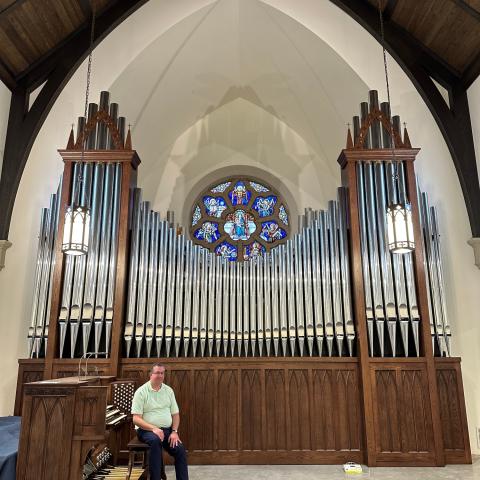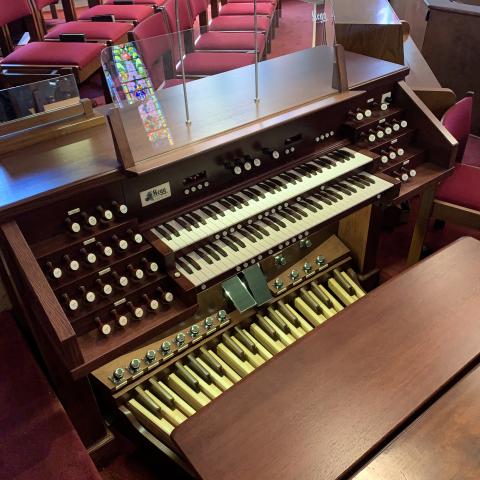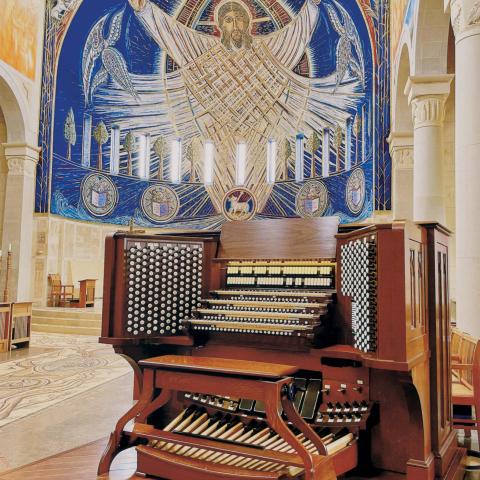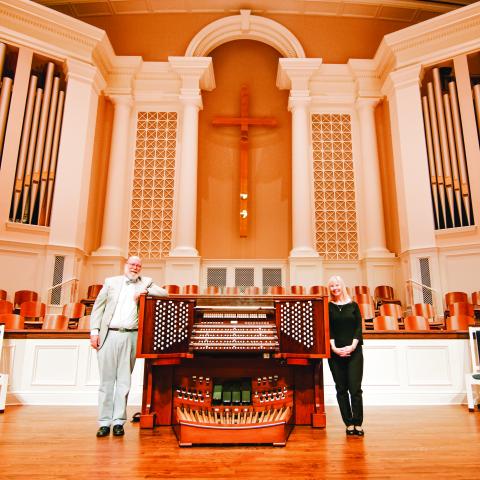Kegg Pipe Organ Builders, Hartville, Ohio; Little Flower Catholic Church, Saint Louis, Missouri

When we were first approached by music director Chuck Chauvin of Little Flower Catholic Church, the conversation was long and rewarding. I immediately felt we were kindred spirits, so close were our thoughts and goals for the organ project. These boiled down to a new organ that would best address the musical needs of the parish, using what pipes were appropriate from the existing organ, and moving the organ pipe location into the room as much as possible.
As with many of our projects, this vibrant church has an active music program, and the existing pipe organ was deficient. The use of the organ in the Catholic Church has changed dramatically in the last seventy years. Also, the location of the musicians at Little Flower was changed some number of years ago. When the church was new, the musicians were in the small gallery and the ambulatory behind the arches. The organ pipes were placed in chambers behind the ambulatory—thus, the organ was quite removed from the room. When the choir and console were moved to the main floor, the distance from the organ pipes became even more of a problem. Several additional organ revisions were made to help, but none were completely successful.
With input from Dr. Horst Buchholz, then music director of the Cathedral Basilica of Saint Louis, Chuck and I devised a plan for the organ. The existing Wicks organ from circa 1950 had several stops that would work well in a new Kegg design. Upon close inspection we realized that some of the stops we would use predated the 1950 organ and building, and were not built by Wicks. But all were well built and voiced, and were in keeping with the Kegg Romantic way of doing things. The overriding goal was to bring the organ forward into the room as much as possible. The structure of the gallery would not support the weight of the entire instrument, so the Great chorus and Pedal Octave were placed in a case on the gallery, with the balance of the organ immediately behind, speaking through the arched openings. The original chambers were made shallower and only contain the largest pipes of the Pedal and the new Tuba. The space behind the organ that was created by moving things forward now contains the blowers, bringing this important element up out of its basement dungeon.
One cannot speak of almost any pipe organ without discussing the room in which it is placed. This is particularly true of Little Flower Church. The building was built with a large budget, just after World War II. It is built of cut stone and round, with a curved dome ceiling containing a stained glass oculus. The dome is covered in acoustic plaster, and there is carpet on most of the floor and aisles. And yet, there is between two and four seconds of reverberation, depending on occupancy. Being a round room, sound produced is rewarding, bass-friendly, but inconsistent. As one walks the space, the acoustic image of the organ (the apparent origin of the sound) moves. It is frequently not where the organ pipes live. While disconcerting at times, the organ sound is always full and rich.
Space available dictated the size of the organ. As it is a modest three-manual organ of twenty-six ranks, we took full advantage of the Kegg philosophy of best use of resources. The Great and Choir divisions share many stops, and the large Swell has some extensions and borrows to add to the versatility, all while retaining the backbone of the instrument with required independent stops. There is a luxurious number of 16′ Pedal stops for an organ of this size, including a Gemshorn and open wood Diapason. The Tuba on ten inches pressure is in the style of E. M. Skinner and is located in its own expression box. The smooth tonality with independent expression makes this stop extremely flexible. It can easily solo out over the instrument or subtly add to it for additional tutti grandeur. With the box closed, it makes a lovely mezzo-forte lyric solo voice. The Great includes our Solo Diapason, which has found favor with many. This stop draws the Great Principal, the Pedal Octave, and the Great Octave, all playing at 8′ pitch. The effect of these three 8′ stops in unison is similar to a First Open Diapason, but with the clarity of a single fine principal. The tenor range is particularly compelling. The Trumpet stop is large and dark in the bass and becomes brighter in the treble, adding the needed fire to the ensemble. The balance of the organ is typical Kegg with a firm bass, rich mid-range, and clean treble.
The organ case is curved to echo the line of the gallery. It is concave in the center and curves forward into two corner towers before returning to the building wall on the sides. The panels of the lower case have the wood grain set at an angle, creating a pleasant visual effect behind the rail. To help with sound to the choir, the Choir division has expression shades on the side as well as the front, to send sound from this division directly to the choir area.
The console is movable and resides with the choir on the main floor. The case has custom carved panels with arches that echo the stone arches seen in the walls all around. The console is fitted with all the expected features, including, of course, the Kegg pencil drawer and cup holder, as seen in Facebook memes. Wine bottle is not included.
I thank Father Lawrence Herzog, pastor, and Chuck Chauvin for their constant support and drive that made this project happen. As with any major church project, a new pipe organ requires vision and determination. These two gentlemen represent a gold standard in this regard. Despite delays due to Covid and a myriad of related issues, their constant work made the project a success.
Kegg Pipe Organ Builders
Charles Kegg, President and Artistic Director
Philip Brown
Erika Burns
Michael Carden
Joyce Harper
Philip Laakso
Nickolas Meyers
Bruce Schutrum
Christopher Soer
Paul Watkins
Builder’s website: www.keggorgan.com/
Church’s website: www.littleflowerstl.org/
GREAT (Manual II)
16′ Gemshorn (fr #14) 12 pipes
8′ Solo Diapason III (fr #1, 2, 23)
(1.) 8′ Principal 61 pipes
8′ Harmonic Flute (fr #15)
8′ Gemshorn (fr #14)
(2.) 4′ Octave 73 pipes
4′ Harmonic Flute (fr #15)
2′ Fifteenth (fr #2)
(3.) 2′ Mixture IV 244 pipes
8′ Tuba (fr #19)
8′ Swell Trumpet (fr #12)
8′ Choir Clarinet (fr #20)
Chimes (Deagan) 25 notes
Great 16
Great Unison Off
Great 4
SWELL (Manual III, enclosed)
(4.) 16′ Gedeckt 73 pipes
(5.) 8′ Geigen Diapason 61 pipes
8′ Gedeckt (fr #4)
(6.) 8′ Salicional 73 pipes
(7.) 8′ Voix Celeste 61 pipes
(8.) 4′ Principal 73 pipes
4′ Salicet (fr #6)
(9.) 4′ Open Flute 73 pipes
(10.) 2-2⁄3′ Nazard 61 pipes
2′ Octave (fr #8)
2′ Piccolo (fr #9)
(11.) 13⁄5′ Tierce (TC) 37 pipes
1-1⁄3′ Larigot (fr #10)
(12.) 16′ Trumpet 85 pipes
8′ Trumpet (fr #12)
(13.) 8′ Oboe 61 pipes
4′ Clarion (fr #12)
Tremulant
Swell 16
Swell Unison Off
Swell 4
CHOIR (Manual I, enclosed)
(14.) 8′ Gemshorn 61 pipes
(15.) 8′ Harmonic Flute 73 pipes
(16.) 8′ Dulciana 61 pipes
(17.) 8′ Unda Maris (TC) 49 pipes
(18.) 4′ Principal 73 pipes
4′ Flute (fr #15)
2′ Octave (fr #18)
8′ Swell Cornet V (fr #4, 9, 10, 11)
8′ Swell Oboe (fr #13)
(19.) 8′ Tuba (high pressure, 61 pipes, separate expression)
(20.) 8′ Clarinet 61 pipes
Tremulant
Choir 16
Choir Unison Off
Choir 4
PEDAL
32′ Resultant (derived)
(21.) 16′ Open Diapason (wood) 32 pipes
(22.) 16′ Bourdon 44 pipes
16′ Gemshorn (fr #14)
16′ Gedeckt (fr #4)
(23.) 8′ Principal 44 pipes
8′ Bass Flute (fr #22)
8′ Gemshorn (fr #14)
4′ Octave (fr #23)
4′ Flute (fr #15)
32′ Harmonics (derived)
16′ Trumpet (fr #12)
8′ Trumpet (fr #12)
4′ Clarinet (fr #20)
INTER-MANUAL COUPLERS
Great to Pedal 8
Great to Pedal 4
Swell to Pedal 8
Swell to Pedal 4
Choir to Pedal 8
Choir to Pedal 4
Swell to Great 16
Swell to Great 8
Swell to Great 4
Choir to Great 16
Choir to Great 8
Choir to Great 4
Swell to Choir 16
Swell to Choir 8
Swell to Choir 4
Great/Choir Transfer
All Swells to Swell
ADJUSTABLE COMBINATIONS
40 memories per User
Unlimited Users
Great 1-2-3-4-5-6 (thumb)
Swell 1-2-3-4-5-6-7-8 (thumb)
Choir 1-2-3-4-5-6 (thumb)
Pedal 1-2-3-4 (toe)
General 1-2-3-4-5-6-7-8-9-10 (thumb/toe)
General 11-12-13-14 (thumb)
General Cancel (thumb)
Set (thumb)
Range (thumb)
Undo (thumb)
Clear (thumb)
Next (General piston sequencer, 4 thumb, 1 toe)
Previous (2 thumb, 1 toe)
Bluetooth Page turn (2 thumb, 1 toe)
REVERSIBLES
Great to Pedal (thumb and toe)
Full Organ (thumb and toe)
32′ Harmonics (toe)
ACCESSORIES
Swell expression pedal
Choir expression pedal
Tuba expression pedal
2-memory adjustable Crescendo pedal
Concave and radiating pedal clavier
Adjustable bench
Full Organ indicator
Transposer
Pencil drawer
Cup holder
TONAL RESOURCES
26 ranks, 23 stops, 1,595 pipes







